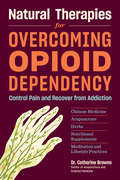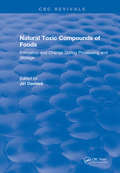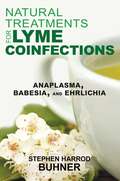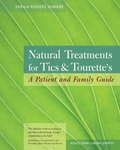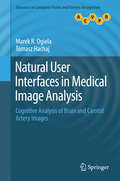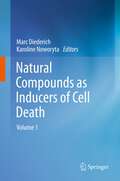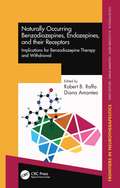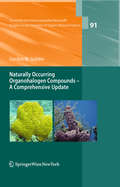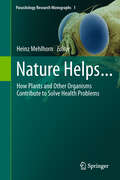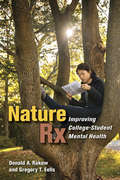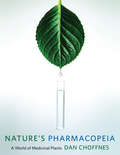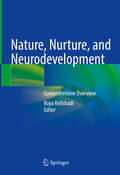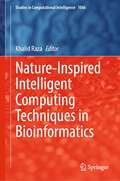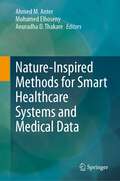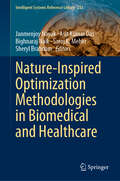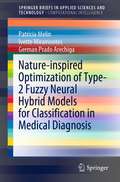- Table View
- List View
Natural Therapies for Overcoming Opioid Dependency: Control Pain and Recover from Addiction with Chinese Medicine, Acupuncture, Herbs, Nutritional Supplements & Meditation and Lifestyle Practices
by Catherine BrowneWith opioid dependency at epidemic levels, Catherine Browne, a doctor of acupuncture and Oriental medicine, provides an accessible and practical guide to the effective use of natural therapies in helping people wean off opioids, manage withdrawal symptoms, and address pain without opioids. Drawing on her extensive clinical experience, Dr. Browne explains how Chinese medicine, acupuncture and acupressure, herbs, essential oils, nutritional supplements, meditation, and exercise can be used to address addiction and restore the body to optimal functioning. Individuals and families who are struggling with addiction, as well as medical practitioners and holistic healthcare professionals, will find help and encouragement in Dr. Browne’s detailed protocols and advice for integrating natural therapies with traditional medical treatment. This publication conforms to the EPUB Accessibility specification at WCAG 2.0 Level AA.
Natural Toxic Compounds of Foods
by Jiri DavidekThis book summarizes the knowledge of naturally occurring toxic and antinutritive food compounds. It includes those plants and animals of value or potential value for human nutrition, either by direct consumption or indirect. as feed for domestic animals. Also included are toxic and antinutritive compounds formed from food components during processing and storage, as well as the toxic and antinutritive compounds present as natural constituents in raw materials and foodstuffs. FEATURES: Discusses food intolerance-inducing compounds, toxins and toxic compounds; Focuses on the most frequently occurring intolerances; Describes the reaction conditions for the formation of these compounds, as well as for their degradation; Considers nitroso compounds and ethyl carbamate formation.
Natural Treatment of Allergies: Learn How to Treat Your Allergies with Safe, Natural Methods
by Anna Huete Ramón RoselloAllergies complicate the lives of those who suffer from them and pose a difficult challenge for contemporary medicine. Environmental factors, stress, a bad diet, or a sedentary life can be the triggers.An allergy is a disproportionate reaction by the immune system to outside substances that are normally innocuous, such as pollen, dust mites, animal hair, or certain foods or medicines. Natural Treatment of Allergies explains why allergies attack and how to reestablish equilibrium.This book is helpful to those who suffer from asthma, hay fever, dermatitis, or dietary intolerance as a result of strong allergies. It presents the most effective natural therapies that lead to recovery. It also includes: The most reliable tests to determine allergies. Related illnesses: how to prevent and cure them. Food that produces allergies. Conventional treatments and their risks. Alternative therapies: naturopathic medicine, acupuncture, homeopathy, Bach flower remedies, and yoga.
Natural Treatments for Lyme Coinfections: Anaplasma, Babesia, and Ehrlichia
by Stephen Harrod BuhnerA guide to the natural treatment of three coinfections of Lyme disease• Reviews the latest scientific research on Babesia, Ehrlichia, and Anaplasma• Reveals how these three conditions often go undiagnosed, complicate the treatment of Lyme disease, and cause symptoms from headache to seizures• Outlines effective natural treatments with herbs and supplements for specific symptoms and to combat overreactions of the immune system and the inflammation responseHarvard researchers estimate there are nearly 250,000 new Lyme disease infections each year--only 10 percent of which will be accurately diagnosed. One of the largest factors in misdiagnosis of Lyme is the presence of other tick-borne infections, which mask or aggravate the symptoms of Lyme disease as well as complicate treatment. Three newly emergent Lyme coinfections are Babesia, Ehrlichia, and Anaplasma. Tens of thousands of people are known to be asymptomatically infected and at least ten percent will become symptomatic this year--with symptoms ranging from chronic headache and arthritis to seizures. Distilling the latest scientific research on Babesia, Ehrlichia, Anaplasma, and Lyme disease, Stephen Buhner examines the complex synergy between these infections and reveals how they can go undiagnosed or resurface after antibiotic treatment. He explains how these organisms create cytokine cascades in the body--essentially sending the immune system into an overblown, uncontrolled inflammatory response in much the same way rheumatoid arthritis or cancer can. Providing an in-depth guide for those suffering from Babesia, Ehrlichia, or Anaplasma infection as well as for clinicians who work with those infected by these organisms, Buhner details effective natural holistic methods centered on herbs and supplements, such as Ashwaganda and Chinese Skullcap, and reveals how to treat specific symptoms, interrupt the cytokine cascades, reduce inflammation, and bring the immune system back into balance. He explains how these natural methods not only complement conventional Lyme disease treatments involving antibiotics and other pharmaceuticals but also provide relief when other forms of treatment have failed.
Natural Treatments for Tics and Tourette's
by Sheila J. RogersThis welcome guide explains how to treat tics and Tourette's syndrome using natural and alternative therapies, from nutritional therapy, behavioral and counseling therapies, EEG biofeedback, and homeopathy to bodywork, energy medicine, and Chinese medicine. Author Sheila Rogers discusses categories of tics including spasmodic facial movements, eye blinking, mild sounds, and humming. She persuasively counters the medical establishment's standard claim that such disorders are "mysterious" and based in genetics. The dramatic spike in cases, she argues, belies this explanation. Natural Treatments for Tics and Tourette's takes a closer look at the environmental factors and underlying physical imbalances that trigger these conditions' symptoms. In this second edition to Tics and Tourette's: Breakthrough Discoveries in NaturalTreatments, Rogers offers a detailed natural treatment plan. No more will patients have to rely on traditional, drug-based treatments that often carry multiple side effects. In eight sections, the book offers advice from medical experts, the latest reports in medical research, a checklist of common tic triggers, inspirational stories from families who have successfully conquered tics and Tourette's, and practical worksheets for readers to use in their treatment and research. Each of the 23 chapters includes a place for notes and "Takeaway Tips" summarizing key points.From the Trade Paperback edition.
Natural Treatments for Tics and Tourette's
by Sheila Rogers DemareThis welcome guide explains how to treat tics and Tourette's syndrome using natural and alternative therapies, from nutritional therapy, behavioral and counseling therapies, EEG biofeedback, and homeopathy to bodywork, energy medicine, and Chinese medicine. Author Sheila Rogers discusses categories of tics including spasmodic facial movements, eye blinking, mild sounds, and humming. She persuasively counters the medical establishment's standard claim that such disorders are "mysterious" and based in genetics. The dramatic spike in cases, she argues, belies this explanation. Natural Treatments for Tics and Tourette's takes a closer look at the environmental factors and underlying physical imbalances that trigger these conditions' symptoms. In this second edition to Tics and Tourette's: Breakthrough Discoveries in NaturalTreatments, Rogers offers a detailed natural treatment plan. No more will patients have to rely on traditional, drug-based treatments that often carry multiple side effects. In eight sections, the book offers advice from medical experts, the latest reports in medical research, a checklist of common tic triggers, inspirational stories from families who have successfully conquered tics and Tourette's, and practical worksheets for readers to use in their treatment and research. Each of the 23 chapters includes a place for notes and "Takeaway Tips" summarizing key points.From the Trade Paperback edition.
Natural User Interfaces in Medical Image Analysis
by Marek R. Ogiela Tomasz HachajThis unique text/reference highlights a selection of practical applications of advanced image analysis methods for medical images. The book covers the complete methodology for processing, analysing and interpreting diagnostic results of sample CT images. The text also presents significant problems related to new approaches and paradigms in image understanding and semantic image analysis. To further engage the reader, example source code is provided for the implemented algorithms in the described solutions. Features: describes the most important methods and algorithms used for image analysis; examines the fundamentals of cognitive computer image analysis for computer-aided diagnosis and semantic image description; presents original approaches for the semantic analysis of CT perfusion and CT angiography images of the brain and carotid artery; discusses techniques for creating 3D visualisations of large datasets; reviews natural user interfaces in medical imaging systems, including GDL technology.
Natural Woman: Herbal Remedies for Radiant Health at Every Age and Stage of Life
by Leslie KornAn herbal guide to support physical, mental, and spiritual health for women and their children at all stages of life--by a healer with over 40 years of experience.Plant medicines are a woman's ally to achieve optimal health; they bring balance and nourishment to daily life and can reduce or eliminate symptoms of physical and emotional distress. They can also provide alternatives to many pharmaceuticals. This go-to herbal sourcebook gives women the tools to thrive throughout their lives, with remedies using common herbs and plants to support a healthy body, mind, and spirit. Dr. Leslie Korn brings over forty years of experience in numerous herbal traditions and healing modalities, offering timeless wisdom in this herbal companion that can be shared with friends and passed down in the family for generations. She offers treatments using common and easy-to-obtain herbs to address sleep disorders, menstrual issues, autoimmune conditions, anxiety, headaches and migraines, stomach issues, fertility issues, postpartum recovery, skin ailments, common discomforts that affect children, and much more.Korn also offers herbal guidance for rites of passage, moments of community, psychoactive herbs, and a protocol for end-of-life care, as well as a comprehensive resources section.
Natural compounds as inducers of cell death
by Karoline Noworyta Marc DiederichCancer still remains a most important killer and even though synthetic chemotherapeutic agents are currently used, they are cost-intensive and do not always meet the expectations. In parallel, there is increasing evidence for the potential of nature-derived compounds on the inhibition of different steps of cancer initiation, promotion and progression. We believe that all diseases can be found in Nature but that Nature also provides the efficient cures as said the Prophet of Allah: "Allah did not create any illness without also creating the remedy". The content of this book gives a multi-disciplinary approach into the anti-cancer research field related to natural products and dietary compounds. Mainly, it covers the area of antitumor activity through an in-depth description of the cytotoxic, anti-inflammatory and anti-oxidant properties in cancer, inflammatory and cardio-vascular diseases. The cell death inducing mechanisms (apoptosis, anti-proliferative activity, angiogenesis, cell cycle control, cytostatic property and autophagy) give an overview of how natural products are able to target cancer cells. We believe that all diseases can be found in Nature but that Nature also provides the efficient cures as said the Prophet of Allah: "Allah did not create any illness without also creating the remedy". The content of this book gives a multi-disciplinary approach into the anti-cancer research field related to natural products and dietary compounds. Mainly, it covers the area of antitumor activity through an in-depth description of the cytotoxic, anti-inflammatory and anti-oxidant properties in cancer, inflammatory and cardio-vascular diseases. The cell death inducing mechanisms (apoptosis, anti-proliferative activity, angiogenesis, cell cycle control, cytostatic property and autophagy) give an overview of how natural products are able to target cancer cells.
Naturalized Bioethics: Toward Responsible Knowing and Practice
by Hilde Lindemann Marian Verkerk Margaret Urban WalkerNaturalized Bioethics represents a revolutionary change in how health care ethics is practiced. It calls for bioethicists to give up their dependence on utilitarianism and other ideal moral theories and instead to move toward a self-reflexive, socially inquisitive, politically critical, and inclusive ethics. Wary of idealizations that bypass social realities, the naturalism in ethics that is developed in this volume is empirically nourished and acutely aware that ethical theory is the practice of particular people in particular times, places, cultures, and professional environments. The essays in this collection examine the variety of embodied experiences of individual people. They situate the bioethicist within the clinical or research context, take seriously the web of relationships in which all human beings are nested, and explore a number of the many different kinds of power relations that inform health care encounters. Naturalized Bioethics aims to help bioethicists, doctors, nurses, allied health professionals, disability studies scholars, medical researchers, and other health professionals address the ethical issues surrounding health care.
Naturally Based Biomaterials and Therapeutics
by Sujata K. Bhatia Veda EswarappaThis book advances biomedical innovations to address the plethora of health problems afflicting the developing world. A panoply of cultural, economic, infrastructural, and other factors prevent many interventions currently popular in the developed world from being similarly effective in the developing world. This book discusses less-traditional approaches, such as naturally based biomaterials and therapeutics, an area that has traditionally been overlooked but has also demonstrated impressive potential for health applications in recent years. This book explores precisely the kinds of applications which can enable countries like India to access more effective, inexpensive treatments while also taking more ownership of their healthcare technologies and innovations.
Naturally Occurring Benzodiazepines, Endozepines, and their Receptors: Implications for Benzodiazepine Therapy and Withdrawal (Frontiers in Neurotherapeutics Series)
by Robert B. Raffa Diana AmanteaUnderstanding and addressing the current opioid crisis requires knowledge of endogenous opioids (endorphins and enkephalins), but there is now evidence for a benzodiazepine crisis. Are there endogenous benzodiazepine-like substances—and what do they do? How do they affect antianxiety drugs and their adverse effects? Do they explain enigmatic prolonged benzodiazepine withdrawal syndrome? This book raises important questions about the clinical consequences of ignoring the existence of or understanding the potential influence of endogenous benzodiazepines on the therapeutic effect of benzodiazepines, their adverse effects, and the problems of withdrawal from them and other benzodiazepine receptor agonists. FEATURES Discusses endogenous benzodiazepine-like substances—what do they do, and do they affect antianxiety drugs and their adverse effects? Presents information on enigmatic prolonged benzodiazepine withdrawal syndrome Describes the compounds acting at the BDZ binding sites, both exogenous (classical BDZ drugs and BDZ from food and plants) and endogenous (endozepines) Assesses the putative interactions in physiology, pathology, and pharmacology of the compounds acting at the BDZ binding sites Dr. Raffa is Adjunct Professor at the University of Arizona College of Pharmacy and Professor Emeritus at Temple University School of Pharmacy. He has co-authored or edited several books on pharmacology and thermodynamics, is a co-editor of two journals, is a past president of the Mid-Atlantic Pharmacology Society, and is the recipient of research and teaching awards. Dr. Amantea is Associate Professor of Pharmacology at the Department of Pharmacy, Health and Nutritional Sciences of the University of Calabria (Italy), where she is the leader of the Stroke Research Unit at the Section of Preclinical and Translational Pharmacology operating in the frame of the Italian Stroke Organization (ISO) Basic Science. She is a member of the Editorial Board and the Guest Editor of the 2016 Neuroscience section of Current Opinion in Pharmacology (Elsevier), and the founder and the editor of the CRC Press Frontiers in Neurotherapeutics series.
Naturally Occurring Organohalogen Compounds - A Comprehensive Update
by Gordon W. GribbleDespite the long association of organohalogen compounds with human activities, nature is the producer of nearly 5,000 halogen-containing chemicals. Once dismissed as accidents of nature or isolation artifacts, organohalogen compounds represent an important and ever growing class of natural products, in many cases exhibiting exceptional biological activity. Since the last comprehensive review in 1996 (Vol. 68, this series), there have been discovered an additional 2,500 organochlorine, organobromine, and other organohalogen compounds. These natural organohalogens are biosynthesized by bacteria, fungi, lichen, plants, marine organisms of all types, insects, and higher animals including humans. These compounds are also formed abiogenically, as in volcanoes, forest fires, and other geothermal events.In some instances, natural organohalogens are precisely the same chemicals that man synthesizes for industrial use, and some of the quantities of these natural chemicals far exceed the quantities emitted by man.
Naturally Selective: Evolution, Orgasm, and Female Choice
by Robert KingResearchers of human behaviour have identified an "orgasm gap": Men usually orgasm during intercourse, whereas women often do not. This book addresses this mystery. The two leading explanations are either that women are “psychologically broken” - Freud’s theory – or badly designed – the “by-product theory.” However, there is a much more compelling third explanation. Evolutionary biology, anatomy, physiology, and direct sex research suggest women have evolved under their own selection pressures and orgasm is a fitness-increasing consequence of such selective factors. This is revealed in their patterns of orgasmic response, which are neither random nor inexplicable.Key Features• Synthesizes decades of peer-reviewed sex research in anatomy, biology, physiology, and behavior.• Engagingly written based on feedback from students, peers, and interested lay persons.• Makes sense of the “orgasm gap” between men and women.• Provides a wider context of human sexual dimorphism and mutual sexual selection.• Balances sex research and real-world research and practical applications.
Nature Helps...
by Heinz MehlhornNature helps... of course at first itself by developing measures that give bacteria, fungi, plants and animals a chance to be successful in their struggle for life. As a latecomer on Earth, Homo sapiens was gifted with some droplets of the divine spirit of recognition and thus became able to observe, to analyse and recombine skills of other living beings and to use them for his overwhelming career over the last 10,000 years. Of course fungi, plants, animals and even bacteria were primarily used by mankind as food or as lifestyle products such as beer, but soon it became clear that there was much more potential hidden in these organisms and that they could be used for other purposes, too. Extracts of plants and fungi were recognized as powerful remedies, as medicines, as insecticides or acarizides, as repellents against parasites or even as weapons, e.g. when poisonous compounds from frogs or plants were applied to arrowheads. Over the last 110 years the pharmaceutical industry has often simulated nature by analyzing complex organic substances taken from living organisms and then producing by synthesis absolutely pure compounds, which mostly consisted of only one single active substance. These products had the advantage of acting against precisely one target and thus produced fewer possible side effects than the complex plant extracts. However, the more serious side effect was that disease agents could develop resistances to pure medicinal products much more easily. Thus after 70 years of excellent prospects for chemotherapy, some dark clouds appeared and quickly gathered, so that several therapeutic remedies now no longer work. Therefore in many countries - especially in those where the pure chemotherapeutics are too expensive for the poor population - the cry "back to nature" is becoming louder and louder. This has led to an enormous increase of studies that again use natural extracts as remedies in the fight against diseases. The present book summarizes examples of promising aspects in a broad spectrum of applications and shows how extracts derived from bacteria, marine organisms, plants or even animals may help to treat infectious diseases, how such organisms may keep away parasites and pests from the bodies of plants or animals, including humans, and how they can be used directly to aid in diagnosis, promote wound healing and even to help catch criminals. These 15 chapters offer not only basic research on these different fields, but also show how useful and effective products can be developed from research.
Nature Rx: Improving College-Student Mental Health
by Donald A. Rakow Gregory T. EellsThe Nature Rx movement is changing campus life. Offering alternative ways to deal with the stress that students are under, these programs are redefining how to provide students with the best possible environment in which to be healthy, productive members of the academic community. In Nature Rx, Donald A. Rakow and Gregory T. Eells summarize the value of nature prescription programs designed to encourage college students to spend time in nature and to develop a greater appreciation for the natural world. Because these programs are relatively new, there are many lessons for practitioners to learn; but clinical studies demonstrate that students who regularly spend time in nature have reduced stress and anxiety levels and improved mood and outlook.In addition to the latest research, the authors present a step-by-step formula for constructing, sustaining, and evaluating Nature Rx programs, and they profile four such programs at American colleges. The practical guidance in Nature Rx alongside the authors' vigorous argument for the benefits of these programs for both students and institutions places Rakow and Eells at the forefront of this burgeoning movement.
Nature's Civil War
by Kathryn Shively MeierIn the Shenandoah Valley and Peninsula Campaigns of 1862, Union and Confederate soldiers faced unfamiliar and harsh environmental conditions--strange terrain, tainted water, swarms of flies and mosquitoes, interminable rain and snow storms, and oppressive heat--which contributed to escalating disease and diminished morale. Using soldiers' letters, diaries, and memoirs, plus a wealth of additional personal accounts, medical sources, newspapers, and government documents, Kathryn Shively Meier reveals how these soldiers strove to maintain their physical and mental health by combating their deadliest enemy--nature.Meier explores how soldiers forged informal networks of health care based on prewar civilian experience and adopted a universal set of self-care habits, including boiling water, altering camp terrain, eradicating insects, supplementing their diets with fruits and vegetables, constructing protective shelters, and most controversially, straggling. In order to improve their health, soldiers periodically had to adjust their ideas of manliness, class values, and race to the circumstances at hand. While self-care often proved superior to relying upon the inchoate military medical infrastructure, commanders chastised soldiers for testing army discipline, ultimately redrawing the boundaries of informal health care.
Nature's Path: A History of Naturopathic Healing in America
by Susan E. CayleffAn eclectic group of firebrands overcame strong odds to create the naturopathic healing system.An alternative medical system emphasizing prevention through healthy living, positive mind-body-spirit strength, and therapeutics to enhance the body’s innate healing processes, naturopathy has gained legitimacy in recent years. In Nature’s Path—the first comprehensive book to examine the complex history and culture of American naturopathy—Susan E. Cayleff tells the fascinating story of the movement’s nineteenth-century roots.While early naturopaths were sometimes divided by infighting, they all believed in the healing properties of water, nutrition, exercise, the sun, and clean, fresh air. Their political activism was vital to their professional formation: they loathed the invasive, depletive practices of traditional medicine and protested against medical procedures that addressed symptoms rather than disease causes while resisting processed foods, pharmaceuticals, environmental toxins, and atomic energy. Cayleff describes the development of naturopathy’s philosophies and therapeutics and details the efforts of its proponents to institutionalize the field. She recognizes notable naturopathic leaders, explores why women doctors, organizers, teachers, and authors played such a strong role in the movement, and identifies countercultural views—such as antivivisection, antivaccination, and vegetarianism—held by idealistic naturopaths from 1896 to the present.Nature’s Path tracks a radical cultural critique, medical system, and way of life that links body, soul, mind, and daily purpose. It is a must-read for historians of medicine and scholars in women’s studies and political history, as well as for naturopaths and all readers interested in alternative medicine.
Nature's Pharmacopeia: A World of Medicinal Plants
by Dan ChoffnesThis beautifully illustrated, elegantly written textbook pairs the best research on the biochemical properties and physiological effects of medicinal plants with a fascinating history of their use throughout human civilization, revealing the influence of nature's pharmacopeia on art, war, conquest, and law. By chronicling the ways in which humans have cultivated plant species, extracted their active chemical ingredients, and investigated their effects on the body over time, Nature's Pharmacopeia also builds an unparalleled portrait of these special herbs as they transitioned from wild flora and botanical curiosities to commodities and potent drugs. The book opens with an overview of the use of medicinal plants in the traditional practices and indigenous belief systems of people in the Americas, Africa, Asia, and ancient Europe. It then connects medicinal plants to the growth of scientific medicine in the West. Subsequent chapters cover the regulation of drugs; the use of powerful plant chemicals—such as cocaine, nicotine, and caffeine—in various medical settings; and the application of biomedicine's intellectual frameworks to the manufacture of novel drugs from ancient treatments. Geared toward nonspecialists, this text fosters a deep appreciation of the complex chemistry and cultural resonance of herbal medicine, while suggesting how we may further tap the vast repositories of the world's herbal knowledge to create new pharmaceuticals.
Nature, Nurture, and Neurodevelopment: Comprehensive Overview
by Roya KelishadiFrom the birth, children grow and learn in response to the stimulation from their social and physical environment. Research on early brain development provides a great opportunity to examine how nature and nurture work together to shape human development. Through the use of sophisticated technology, scientists have discovered how early brain development and nurturing care interact to create a foundation for future growth and learning. New evidence supports the effect of nature-nurture interactions on childhood development primarily through advances in longitudinal studies. Neural processes, influenced by genetic and epigenetic variation, and other underlying factors including environment, infection, inflammation, hormonal and immune functions, etc., have critical roles in brain development. The term "nurturing care" was described as a core component for achieving optimal development in the early years of life, when the brain is developing and the child is more responsive to interventions. Recent evidence has revealed that parenting interventions that include components to enhance child learning or strengthen parent-child relationships are effective for improving early cognitive, language, motor, and socioemotional development. This book aims: (1) to describe various domains of neurodevelopment in children; (2) to report the estimates of children at risk of not achieving their developmental potential; (3) to present a life course conceptual framework of early childhood development; (4) to review new aspects of neurodevelopment in children; eg., neurobiology, neuroimmunology; (5) to describe the risk factors affecting early brain development; (6) to report the neurodevelopment screening tools in children; (7) to assess the role of nurturing care in early brain development; and (8) to describe programs and policies implemented for early childhood development and their effectiveness for improving development in childhood.
Nature-Based Allied Health Practice: Creative and Evidence-Based Strategies
by Amy Wagenfeld Shannon MarderThe benefits of interacting with nature for our social, cognitive, and physical wellbeing are well documented. But how practical is it to take therapy into nature, or bring nature into therapy?This evidence-based and accessible guide demonstrates easily workable, creative, tried-and-tested strategies for bringing nature into therapy. It includes simple and fun ready-to-go activity ideas. Using the life-course as a framework, the authors highlight the impact of nature at every stage of human development. From younger children to older adults, anyone can benefit from outdoor therapy, and different therapeutic offerings can be adapted to suit most individuals and groups. Resources are included to help assess a program's readiness to incorporate nature, create plans to take therapy outdoors (or bring the outside in), and evaluate the impact it could have for patients or clients.With testimonials from service users who have felt the benefits of nature-based practices, and case studies highlighting excellence in practice from health and social care professionals across various fields, this book will inspire and empower allied health and mental health practitioners to take their therapy practice outdoors.
Nature-Inspired Intelligent Computing Techniques in Bioinformatics (Studies in Computational Intelligence #1066)
by Khalid RazaThis book encapsulates and occupies recent advances and state-of-the-art applications of nature-inspired computing (NIC) techniques in the field of bioinformatics and computational biology, which would aid medical sciences in various clinical applications. This edited volume covers fundamental applications, scope, and future perspectives of NIC techniques in bioinformatics including genomic profiling, gene expression data classification, DNA computation, systems and network biology, solving personalized therapy complications, antimicrobial resistance in bacterial pathogens, and computer-aided drug design, discovery, and therapeutics. It also covers the role of NIC techniques in various diseases and disorders, including cancer detection and diagnosis, breast cancer, lung disorder detection, disease biomarkers, and potential therapeutics identifications.
Nature-Inspired Methods for Smart Healthcare Systems and Medical Data
by Mohamed Elhoseny Ahmed M. Anter Anuradha D. ThakareThis book aims to gather high-quality research papers on developing theories, frameworks, architectures, and algorithms for solving complex challenges in smart healthcare applications for real industry use. It explores the recent theoretical and practical applications of metaheuristics and optimization in various smart healthcare contexts. The book also discusses the capability of optimization techniques to obtain optimal parameters in ML and DL technologies. It provides an open platform for academics and engineers to share their unique ideas and investigate the potential convergence of existing systems and advanced metaheuristic algorithms. The book's outcome will enable decision-makers and practitioners to select suitable optimization approaches for scheduling patients in crowded environments with minimized human errors.The healthcare system aims to improve the lives of disabled, elderly, sick individuals, and children. IoT-based systems simplify decision-making and task automation, offering an automated foundation. Nature-inspired metaheuristics and mining algorithms are crucial for healthcare applications, reducing costs, increasing efficiency, enabling accurate data analysis, and enhancing patient care. Metaheuristics improve algorithm performance and address challenges in data mining and ML, making them essential in healthcare research. Real-time IoT-based healthcare systems can be modeled using an IoT-based metaheuristic approach to generate optimal solutions.Metaheuristics are powerful technologies for optimization problems in healthcare systems. They balance exact methods, which guarantee optimal solutions but require significant computational resources, with fast but low-quality greedy methods. Metaheuristic algorithms find better solutions while minimizing computational time. The scientific community is increasingly interested in metaheuristics, incorporating techniques from AI, operations research, and soft computing. New metaheuristics offer efficient ways to address optimization problems and tackle unsolved challenges. They can be parameterized to control performance and adjust the trade-off between solution quality and resource utilization. Metaheuristics manage the trade-off between performance and solution quality, making them highly applicable to real-time applications with pragmatic objectives.
Nature-Inspired Optimization Methodologies in Biomedical and Healthcare (Intelligent Systems Reference Library #233)
by Sheryl Brahnam Janmenjoy Nayak Bighnaraj Naik Asit Kumar Das Saroj K. MeherThis book introduces a variety of well-proven and newly developed nature-inspired optimization algorithms solving a wide range of real-life biomedical and healthcare problems. Few solo and hybrid approaches are demonstrated in a lucid manner for the effective integration and finding solution for a large-scale complex healthcare problem. In the present bigdata-based computing scenario, nature-inspired optimization techniques present adaptive mechanisms that permit the understanding of complex data and altering environments. This book is a voluminous collection for the confront faced by the healthcare institutions and hospitals for practical analysis, storage, and data analysis. It explores the distinct nature-inspired optimization-based approaches that are able to handle more accurate outcomes for the current biomedical and healthcare problems. In addition to providing a state-of-the-art and advanced intelligent methods, it also enlightens an insight for solving diversified healthcare problems such as cancer and diabetes.
Nature-inspired Optimization of Type-2 Fuzzy Neural Hybrid Models for Classification in Medical Diagnosis (SpringerBriefs in Applied Sciences and Technology)
by Patricia Melin Ivette Miramontes German Prado ArechigaThis book describes the utilization of different soft computing techniques and their optimization for providing an accurate and efficient medical diagnosis. The proposed method provides a precise and timely diagnosis of the risk that a person has to develop a particular disease, but it can be adaptable to provide the diagnosis of different diseases. This book reflects the experimentation that was carried out, based on the different optimizations using bio-inspired algorithms (such as bird swarm algorithm, flower pollination algorithms, and others). In particular, the optimizations were carried out to design the fuzzy classifiers of the nocturnal blood pressure profile and heart rate level. In addition, to obtain the architecture that provides the best result, the neurons and the number of neurons per layers of the artificial neural networks used in the model are optimized. Furthermore, different tests were carried out with the complete optimized model. Another work that is presented in this book is the dynamic parameter adaptation of the bird swarm algorithm using fuzzy inference systems, with the aim of improving its performance. For this, different experiments are carried out, where mathematical functions and a monolithic neural network are optimized to compare the results obtained with the original algorithm. The book will be of interest for graduate students of engineering and medicine, as well as researchers and professors aiming at proposing and developing new intelligent models for medical diagnosis. In addition, it also will be of interest for people working on metaheuristic algorithms and their applications on medicine.
